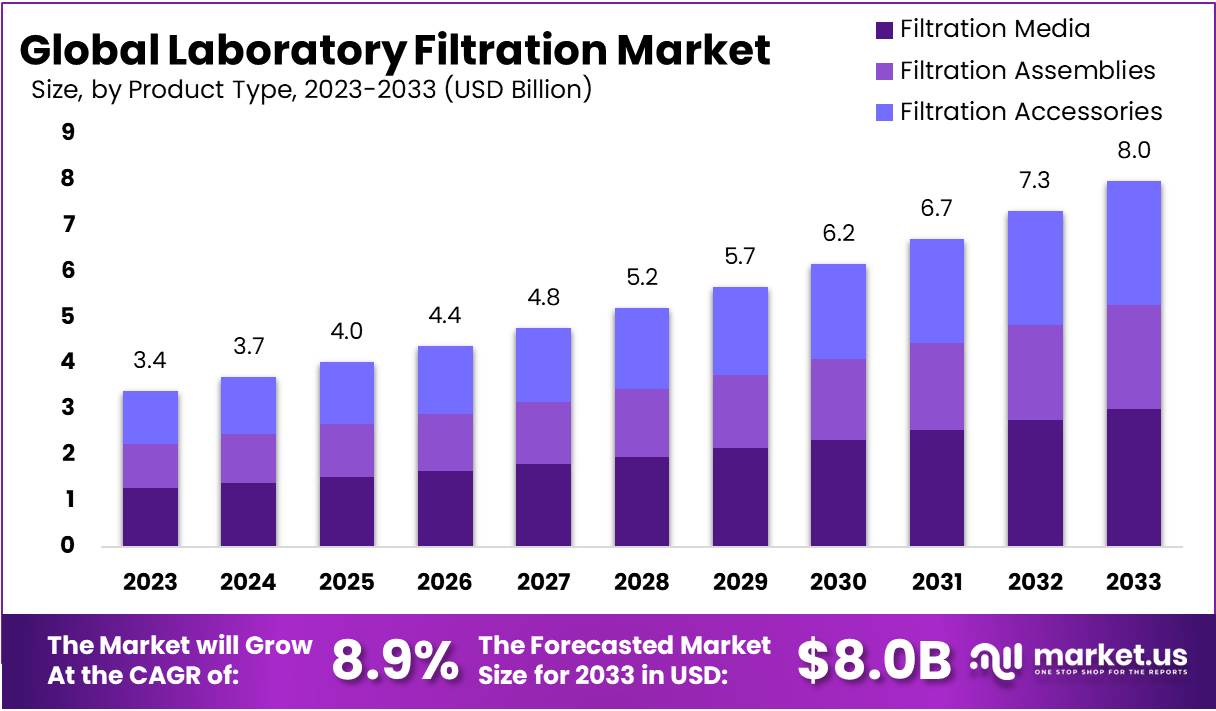Introduction
The Laboratory Filtration Market is projected to experience significant growth, expanding from USD 3.4 billion in 2023 to approximately USD 8 billion by 2033. This increase represents a Compound Annual Growth Rate (CAGR) of 8.9% from 2024 to 2033. Key drivers of this growth include technological advancements and increasing demand across various industries for enhanced filtration solutions.
Technological innovation is a pivotal factor propelling this market. Developments in membrane technologies that support higher flux performance and reduced fouling are critical. Notably, the adoption of Tangential Flow Filtration (TFF) systems is improving membrane longevity and operational efficiency by preventing molecule build-up on the membrane surface.
Collaborative efforts between universities and industry leaders are fostering significant advancements in filtration technology. These partnerships are not only enhancing scientific research but also ensuring the practical application of innovations in commercial settings. The focus is increasingly on developing novel filtration methods and materials that address real-world demands effectively.
The importance of educational and training programs cannot be overstated, as they equip new generations of professionals with advanced skills in filtration technology. These programs, often developed in collaboration with industry giants, ensure that the curriculum remains relevant to current and emerging technological needs.
Furthermore, the laboratory filtration sector is adapting to stringent regulatory and safety standards, especially in critical industries such as pharmaceuticals, food and beverage, and environmental sciences. Compliance with these regulations ensures high-quality filtration processes that meet health and safety standards.
Market expansion is also a significant trend, with laboratory filtration technology finding new applications in biotechnology and environmental testing. The global push for rapid and precise testing solutions, driven by public health challenges, underscores the growing reliance on advanced filtration techniques. This expansion not only broadens the market’s scope but also highlights its role in addressing pressing global health issues.

Key Takeaways
- The Laboratory Filtration Market is expected to expand from US$ 3.4 billion in 2023 to US$ 8 billion by 2033, growing at a CAGR of 8.9%.
- Filtration Media dominates the market, holding a 37.8% share, underlining its essential role in laboratory operations.
- Microfiltration leads the technology segment in 2023 with a 26.8% share, followed by nanofiltration, vacuum filtration, ultrafiltration, and reverse osmosis.
- North America holds a major market share of 38.6%, valuing at $1.3 billion in 2023, showcasing its market leadership.
- Key market players include Antylia Scientific, Agilent Technologies Inc., Merck KGaA, Danaher Corporation, and Veolia Water Technologies.
- Current trends highlight a shift towards single-use filtration systems, sustainable practices, and enhanced automation and digitalization in the sector.
- The market is evolving through continuous technological advancements, dynamic market conditions, and significant contributions from leading companies.
Emerging Trends
- Natural Materials for Filtration: The use of natural substances is gaining traction in filtration technology. Researchers are integrating cellulose with silk-based fibrils to develop new filtration materials. These are not only effective in removing contaminants but also possess antimicrobial properties. This dual functionality is crucial, as it helps prevent fouling from bacteria and fungi, enhancing the durability and efficiency of filters.
- Depth Filtration Advances: Depth filtration is seeing a resurgence, especially in bioprocessing applications. It is being paired with single-use manufacturing techniques, which is pivotal for the biomanufacturing sector. This combination enhances the clarity and purity of bioproducts by effectively removing proteins and other impurities from process streams.
- Xylem-Based Filters: There is innovative work in utilizing xylem—the woody tissue in plants—to create effective, low-cost water filters. These filters are particularly adept at removing bacterial contaminants. They are simple to produce and potentially transformative for water purification in resource-limited settings, making clean water more accessible.
- High-Efficiency Membrane Filtration: The technologies of ultrafiltration, nanofiltration, and reverse osmosis are evolving to better tackle a broader spectrum of contaminants. These include microbes and dissolved minerals. Their enhanced performance is crucial in regions where traditional water treatment systems are inadequate, providing a more reliable means of obtaining clean water.
Use Cases
- Portable Drinking Water Treatment: Xylem filters have proven effective in field tests conducted in India. These filters are simple and cost-effective, making them ideal for providing safe drinking water in areas lacking reliable water sources. Their deployment could revolutionize water purification practices worldwide by making clean water accessible to underserved populations.
- Biomanufacturing Process Optimization: Depth filtration is gaining prominence in bioprocessing to improve product purity and increase yields. It is crucial during the initial clarification steps and continues to play a role throughout the biomanufacturing process. This technology is integral to producing high-quality biopharmaceuticals, ensuring that each step meets stringent purity standards.
- Community-Scale Water Solutions: Reverse osmosis systems have been instrumental in addressing water purity challenges in communities with longstanding water advisories. These systems can provide tens of thousands of liters of clean water each day. They are particularly vital during emergencies, ensuring uninterrupted access to safe drinking water and supporting community resilience.
- Research and Development: Innovative filtration materials, such as those that combine natural silk and cellulose, are being developed at the research level. These materials show significant promise for eventual application at industrial and municipal scales. They represent a sustainable approach to tackling global water contamination issues, offering a greener alternative to traditional filtration technologies.
Regional Analysis
In 2023, North America dominated the Laboratory Filtration Market, holding a significant share of over 38.6% and a market value of USD 1.3 billion. This supremacy is driven by robust research infrastructure and continuous technological advancements in laboratory filtration. The region boasts a wealth of research institutions, pharmaceutical companies, and biotechnology firms, creating a strong demand for sophisticated filtration technologies.
The region’s commitment to innovation is evident in the increased research and development activities across various industries. Laboratories conducting complex and sensitive experiments require precise and reliable filtration systems, which has led to a surge in demand for these technologies. This need supports the thriving market for laboratory filtration in North America.
North America’s prominence in the healthcare and biotechnology sectors further boosts the Laboratory Filtration Market. It serves as a global center for pharmaceutical production, bioprocessing, and diagnostic research, which necessitates advanced filtration solutions for sterilization, clarification, and purification processes.
The heightened awareness of environmental sustainability in the region has spurred the adoption of eco-friendly filtration solutions. Government initiatives promoting research and development also play a crucial role in market growth. These efforts, coupled with the presence of leading market players, foster a competitive and innovative market environment.
Conclusion
In conclusion, the Laboratory Filtration Market is set to witness substantial growth, driven by relentless technological advancements and growing demands in diverse industries. Innovations in filtration technology, such as enhanced membrane systems and sustainable materials, are pivotal to this expansion. Strategic collaborations between academic institutions and industry leaders are instrumental in refining these technologies and ensuring their practical application across various sectors. Moreover, the shift towards single-use systems and sustainable practices reflects the industry’s adaptation to global health needs and environmental standards. Collectively, these elements underscore a robust market trajectory, poised to redefine purity standards in crucial industries while supporting global health initiatives.
Discuss your needs with our analyst
Please share your requirements with more details so our analyst can check if they can solve your problem(s)



